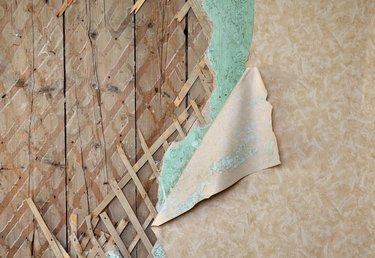
Rock lath, also referred to as gypsum lath or button board, is a traditional base material used to support plaster. Other laths include wood, metal and veneer. Rock lath and plaster can be found in the walls and ceilings of many older commercial and residential buildings. In modern times, rock lath and plaster is applied as a decorative alternative to drywall.
History
Video of the Day
Rock lath has been used in building projects since the early 1900s. Rock lath became a practical alternative to wood and metal lath because it was less expensive and saved time during construction. Builders were able to save on material and labor costs because rock lath required only two coats of plaster, rather than the three coats customarily used with wood and metal laths. By the 1930s, rock lath was the primary lath used in residential buildings.
Video of the Day
Characteristics
Rock lath consists of a gypsum core between paper coverings. The paper on the face side is infused with gypsum crystals that bond with the wet plaster to hold it securely in place, while the inside covering resists moisture to prevent the core from softening. Some older rock lath was perforated to allow the plaster to sink into the perforations, forming plaster "keys." Rock lath typically comes in boards that measure 16 inches by 48 inches and are 3/8-inch thick, and it can be easily scored and cut at the construction site.
Use and Application
Rock lath is generally used in interior walls and ceilings. Builders attach it to framing with nails, screws or staples and then apply a base coat of cement plaster to it, followed by a second coat of hard finish plaster. The minimum thickness of these coats combined is 1/2 inch, with the first coat being 1/4- to 3/8-inch thick, and the second about 1/8-inch thick.
Problems
Over time, the walls or ceilings of buildings constructed with rock lath can develop long cracks between the lath boards. This is usually due to the building shifting over time, or heavy loads weighing down rock lath ceilings. While these cracks are difficult to prevent or repair, builders can cover them with a fiberglass mesh tape, spackled over or hidden by a layer of drywall.